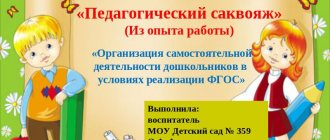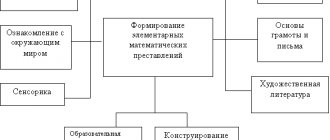Activities of a preschool teacher in the context of the implementation of the Federal State Educational Standard
Tatiana
Activities of a preschool teacher in the context of the implementation of the Federal State Educational Standard
Federal State Educational Standard ( FSES )
— a set of mandatory requirements for education of a certain level and
(or)
for a profession, specialty and area of training, approved by the federal executive body exercising the functions of developing state policy and legal regulation in the field of education.
“
TEACHER IN THE CONDITIONS OF INTRODUCTION OF THE FSES DO ” The system of Russian education at the present stage of development of society is undergoing significant changes associated with a change in the model of cultural and historical development. But no matter what reforms take place in the education system, in the end they, one way or another, are limited to a specific performer - the teacher. It is the teacher who is the main figure in the implementation of major innovations in practice. And for the successful introduction of various innovations into practice, for of the tasks assigned to him in new conditions,
The new federal law “On Education in the Russian Federation”
, preschool education is separated into an independent level of general education. On this basis, the federal state educational standard for preschool education was adopted.
What changes have occurred in the preschool education system?
Here, for the first time, guidelines are essentially given for what working with a child in preschool is, what requirements are placed on it, what conditions ensure its effectiveness and quality.
One of the unique aspects of the standard is that the educational program is defined here as a program of psychological and pedagogical support, positive socialization, individualization of the child, and not the acquisition of knowledge, as is done in other standards of the education system. Naturally, despite the absence of such forms of control that exist at higher levels of education, both teachers and parents themselves want to understand what the child managed to achieve. According to the standard, the correct assessment will be the vector of development that the child is following, rather than some final result that needs to be achieved. Here, unlike other standards, we are talking only about personal results. In this regard, monitoring the dynamics of a child’s development is allowed, but it is not needed for assessment in itself, but to identify the ways in which a teacher can help a child develop, discover some abilities, and overcome problems.
The standard requirements for the results of mastering the Program are presented in the form of targets for preschool education, which represent social and normative age characteristics of the child’s possible achievements at the stage of completion of preschool education.
The standard affirms the basic principles of: assistance and cooperation between children and adults in the process of children's development and their interaction with people, culture and the world around them; introducing children to sociocultural norms, traditions of the family, society and state; formation of cognitive interests and cognitive actions of the child through his inclusion in various types of activities ; taking into account the ethnocultural and social situation of children’s development
The standard provides variability and diversity in the content of educational programs and organizational forms of the level of preschool education, the possibility of creating educational programs of various levels of complexity and focus, taking into account the educational needs and abilities of students ; formation of a sociocultural environment appropriate to the age and individual characteristics of children.
The standard ensures equal opportunities for the full development of each child during preschool childhood, regardless of place of residence, gender, nation, language, social status, psychophysiological characteristics (including disabilities)
; ensuring continuity of basic educational programs of preschool and primary general education; determining directions for systematic interdepartmental interaction, as well as interaction between pedagogical and public associations.
I believe that one of the important changes in the preschool education system is the development of a basic preschool education program, which consists of a mandatory part and a part formed by the participants in educational relations. The mandatory part of the Program requires a comprehensive approach, ensuring development in all educational areas, of which there are five:
social and communicative development;
cognitive development;
speech development;
artistic and aesthetic development;
physical development.
The part formed by the participants in educational relations presents independently developed Programs aimed at the development of children in one or more educational areas, methods, forms of organizing educational work, the volume of the educational part of the Program is determined - at least 60%. For the first time, the requirements for the result of mastering the program have been defined in the form of target guidelines for preschool education. Corrective work and inclusive education are provided.
An important role is played by the creation of the necessary conditions for the implementation of the Program .
All these changes in the preschool education system affect the professional activities of the teacher .
The standard is aimed at individualizing the development of a child; the processes of learning and upbringing are combined into a holistic educational process based on spiritual, moral and sociocultural values and socially accepted rules and norms of behavior in the interests of the individual, family and society. Life in kindergarten for a child should become one big game with its own norms and rules, and the teacher will need great skill in presenting program material so that the child does not notice that he is being taught something, and he himself is the discoverer and researcher. Constantly using the principle of partnership interaction is quite difficult and requires the teacher to have great experience in communicating with children.
The introduction of the Federal State Educational Standard will entail a lot of and very labor-intensive work, namely:
— making changes to the educational program, almost completely changing its structure;
- building new ones (maybe not new, but different)
relationships with parents, because there is
“direct involvement of parents in the educational process
,” but in practice this is a very difficult matter;
— adjustment of documentation, plans, familiarization with updated programs, drawing up work programs.
Drawing up a work program and developing a pedagogical project are the cause of the most significant professional difficulties, since this work requires high professionalism and knowledge.
The world around us is constantly becoming more informationally complex . Today, it is no longer enough to once receive a basic education and work in your specialty. In order to meet modern requirements and maintain the level of competence, it is necessary to constantly study and engage in self-education. Continuing education must become a necessity. The need to improve the level of knowledge, skills and abilities penetrates all spheres of life - professional, family, social, personal and, of course, the sphere of teaching .
Currently, not just a teacher , but a teacher-researcher, educational psychologist, and educational technologist. These qualities of a specialist after graduating from a pedagogical university or pedagogical college can only develop in the conditions of a creatively , problematically and technologically organized educational process in a preschool institution.
The teacher must constantly improve himself and improve his skills.
The role of the teacher in the life of the child and society
In the educational process, in the context of the implementation of the Federal State Educational Standard, the issue of ensuring conditions for the development of the child’s personal growth comes to the fore. This is due to the need to integrate the individual into society as a creative individual, capable of mastering spiritual values and forming a specific selective orientation associated with the expansion of subjective meanings.
The most significant characteristics of the personality of a modern teacher in her fundamental research are highlighted by Professor Evgenia Vasilyevna Bondarevskaya [1]:
- Humanistic pedagogical position.
- Mastery of advanced pedagogical technologies.
- Accumulation and use of experience in creative activities.
- The ability to justify and build one’s own activities as a system.
- Possession of a culture of professional behavior, the ability for self-development (the ability to self-regulate one’s own personality and activities).
In our opinion, these personal characteristics most correspond to modern requirements for the professional activity of a teacher working with children who have health limitations. Possession of such qualities allows him to skillfully set and daily solve complex correctional and developmental tasks for correction and improvement:
- perceptions and ideas;
- memory and attention;
- imaginative thinking and self-esteem;
- emotional-volitional sphere of the child.
The teacher in the group is the bearer of a certain model of behavior, and children, being nearby during the day, see and hear how the teacher speaks, what his facial expression, intonation, and timbre of voice are. In some ways, consciously or unconsciously, they copy him.
A number of personal characteristics should include qualities that become professionally significant prerequisites for creating favorable relationships in the educational process. These qualities include patience, responsibility, commitment, objectivity, respect for people, optimism, emotional balance, the need for communication, interest in the lives of students, goodwill, restraint, responsiveness and many others.
Professional qualities of a preschool teacher
Important professional qualities of a teacher are hard work, efficiency, discipline, responsibility, the ability to set a goal, choose ways to achieve it, organization, perseverance, systematic and systematic improvement of one’s professional level, the desire to constantly improve the quality of one’s work, etc.
All modern researchers note that it is love for children that should be considered the most important personal and professional trait of a teacher, without which effective teaching activities are impossible.
Functions of a preschool teacher:
Constant communication with the child is the most important job function of a teacher. The teacher must be able to give age-appropriate answers to many questions. The life of children in a preschool institution depends on how correctly and how quickly the teacher finds an approach to each child and is able to organize it, whether the children will be calm, affectionate, and sociable or whether they will grow up restless, wary, and withdrawn.
Planning, organizing and conducting educational work.
Ensuring the protection and promotion of children's health.
Introducing children to national culture and traditions.
Coordination of the activities of the assistant teacher and other workers within the framework of a single educational process.
Types of advanced training for teachers
There are different types of advanced training for kindergarten teachers. They can take place both online and offline. For example:
- Short lectures and seminars up to 24 hours Typically they cover one or more topics.
- Short-term courses up to 72 hours These courses cover highly specialized issues. In general, the courses use an integrated approach, in which theoretical lessons alternate with practical exercises.
- Long courses from 100 hours These are more general programs that cover a large number of issues.
- Internships and joint scientific activities This format involves a lot of practical part.
At the end of any training, certification is carried out. If the teacher successfully passes it, he receives a document, a certificate of advanced training.



